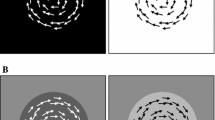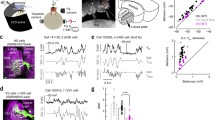Abstract
It has been concluded in the preceding papers (Egelhaaf, 1985a, b) that two functional classes of output elements of the visual ganglia might be involved in figure-ground discrimination by relative motion in the fly: The Horizontal Cells which respond best to the motion of large textured patterns and the FD-cells which are most sensitive to small moving objects. In this paper it is studied by computer simulations (1) in what way the input circuitry of the FD-cells might be organized and (2) the role the FD-cells play in figure-ground discrimination.
The characteristic functional properties of the FD-cells can be explained by various alternative model networks. In all models the main input to the FD-cells is formed by two retinotopic arrays of small-field elementary movement detectors, responding to either front-to-back or back-to-front motion. According to their preferred direction of motion the FD-cells are excited by one of these movement detector classes and inhibited by the other. The synaptic transmission between the movement detectors and the FD-cells is assumed to be non-linear. It is a common property of all these model circuits that the inhibition of the FD-cells induced by large-field motion is mediated by pool cells which cover altogether the entire horizontal extent of the visual field of both eyes. These pool cells affect the response of the FD-cells either by pre- or postsynaptic shunting inhibition. Depending on the FD-cell under consideration, the pool cells are directionally selective for motion or sensitive to motion in either horizontal direction.
The role the FD-cells and the Horizontal Cells are likely to play in figure-ground discrimination can be demonstrated by computer simulations of a composite neuronal model consisting of the model circuits for these cell types. According to their divergent spatial integration properties they perform different tasks in figure-ground discrimination: Whereas the Horizontal Cells mainly mediate information on wide-field motion, the FD-cells are selectively tuned to efficient detection of relatively small targets. Both cell classes together appear to be sufficient to account for figure-ground discrimination as it has been shown by analysis at the behavioural level.
Similar content being viewed by others
References
Baker, C.L., Braddick, O.J.: Does segregation of differently moving areas depend on relative or absolute displacement. Vision Res. 22, 851–856 (1982)
Bishop, L.G., Keehn, D.G., McCann, G.D.: Motion detection by interneurons of optic lobes and brain of the flies Calliphora phaenicia and Musca domestica. J. Neurophysiol. 31, 509–525 (1968)
Buchner, E., Buchner, S., Bülthoff, I.: Deoxyglucose mapping of nervous activity induced in Drosophila brain by visual movement. J. Comp. Physiol. A 155, 471–483 (1984)
Buchner, E., Buchner, S., Hengstenberg, R.: 2-Deoxy-D-Glucose maps movement-specific nervous activity in the second visual ganglion of Drosophild. Science 205, 687–688 (1979)
DeVoe, R.D.: Movement sensivitities of cells in the fly's medulla. J. Comp. Physiol. 138, 93–119 (1980)
DeVoe, R.D., Ockleford, E.M.: Intracellular responses from cells of the medulla of the fly, Calliphora erythrocephala. Biol. Cybern.. 23, 13–24 (1976)
Doorn, A.J. van, Koenderink, J.J.: Visibility of movement gradients. Biol. Cybern. 44, 167–175 (1982)
Eckert, H., Dvorak, D.R.: The centrifugal horizontal cells in the lobula plate of the blowfly, Phaenicia sericata. J. Insect Physiol. 29, 547–560 (1983)
Egelhaaf, M.: On the neuronal basis of figure-ground discrimination by relative motion in the visual system of the fly. I: Behavioural constraints imposed on the neuronal network and the role of the optomotor system. Biol. Cybern. 52, 123–140 (1985a)
Egelhaaf, M.: On the neuronal basis of figure-ground discrimination by relative motion in the visual system of the fly. II: Figure-detection cells, a new class of visual interneurones. Biol. Cybern. 52, 195–209 (1985b)
Fermi, G., Reichardt, W.: Optomotorische Reaktionen der Fliege Musca domestica. Abhängigkeit der Reaktion von der Wellenlänge, der Geschwindigkeit, dem Kontrast und der mittleren Leuchtdichte bewegter periodischer Muster. Kybernetik 2, 15–28 (1963)
Götz, K.G.: Optomotorische Untersuchung des visuellen Systems einiger Augenmutanten der Fruchtfliege Drosophila. Kybernetik 2, 77–92 (1964)
Götz, K.G.: Flight control in Drosophila by visual perception of motion. Kybernetik 4, 199–208 (1968)
Hausen, K.: Struktur, Funktion und Konnektivität bewegungsempfindlicher Interneurone in dritten optischen Neuropil der Schmeißfliege Calliphora erythrocephala. Doctoral Dissertation, Universität Tübingen (1976)
Hausen, K.: Monocular and binocular computation of motion in the lobula plate of the fly. Verh. Dtsch. Zool. Ges. 74, 49–70 (1981)
Hausen, K.: Motion sensitive interneurons in the optomotor system of the fly. I. The horizontal cells: structure and signals. Biol. Cybern. 45, 143–156 (1982a)
Hausen, K.: Motion sensitive interneurons in the optomotor system of the fly. II. The horizontal cells: receptive field organization and response characteristics. Biol. Cybern. 46, 67–79 (1982b)
Hausen, K.: The lobula-complex of the fly: Structure, function, and significance in visual behaviour. In: Photoreception and vision in invertebrates, pp. 523–559. Ali, M.A., ed. New York, London, Plenum Press 1984
McCann, G.D., Dill, J.C.: Fundamental properties of intensity, form, and motion perception in the visual nervous systems of Calliphora phaenicia and Musca domestica. J. Gen. Physiol. 53, 385–413 (1969)
McCann, G.D., MacGinitie, G.F.:Opttomotor response of insect vision. Proc. R. Soc. Lond. B 163, 369–401 (1965)
Mimura, K.: Movement discrimination by the visual system of flies. Z. Vergl. Physiol. 73, 105–138 (1971)
Mimura, K.: Neural mechanisms, subserving directional selectivity of movement in the optic lobe of the fly. J. Comp. Physiol. 80, 409–437 (1972)
Poggio, T., Reichardt, W., Hausen, K.: A neuronal circuitry for relative movement discrimination by the visual system of the fly. Naturwissenschaften 68, 443–446 (1981)
Reichardt, W., Poggio, T.: Figure-ground discrimination by relative movement in the visual system of the fly. Part I. Experimental results. Biol. Cybern. 35, 81–100 (1979)
Reichardt, W., Poggio, T., Hausen, K.: Figure-ground discrimination by relative movement in the visual system of the fly. Part II: Towards the neuronal circuitry. Biol. Cybern. 46 (Suppl.), 1–30 (1983)
Strausfeld, N.J.: Atlas of an insect brain. Berlin, Heidelberg, New York: Springer 1976
Strausfeld, N.J.: Functional neuroanatomy of the blowfly's visual system. In: Photoreception and vision in invertebrates, pp. 483–522. Ali, M.A., ed. New York, London: Plenum Press 1984
Strausfeld, N.J., Bacon, J.P.: Multimodal convergence in the central nervous system of dipterous insects. In: Fortschritte der Zoologie, Bd. 28, pp 47–76. Horn, E., ed. Stuttgart, New York: Gustav Fischer 1983
Strausfeld, N.J., Bassemir, U., Singh, R.N., Bacon, J.P.: Organizational principles of outputs from dipteran brains. J. Insect. Physiol. 30, 73–93 (1984)
Wagner, H.: Flight performance and visual control of flight of the free flying housefly (Musca domestica L.). Doctoral Dissertation, Universität Tübingen (1985)
Author information
Authors and Affiliations
Rights and permissions
About this article
Cite this article
Egelhaaf, M. On the neuronal basis of figure-ground discrimination by relative motion in the visual system of the fly. Biol. Cybern. 52, 267–280 (1985). https://doi.org/10.1007/BF00336983
Received:
Issue Date:
DOI: https://doi.org/10.1007/BF00336983




